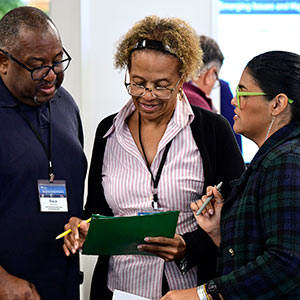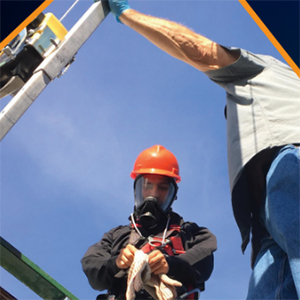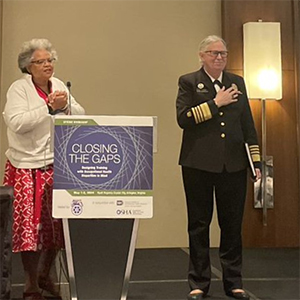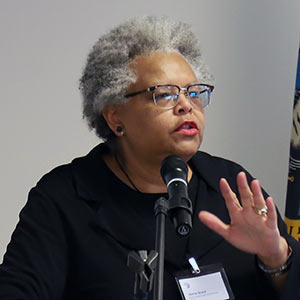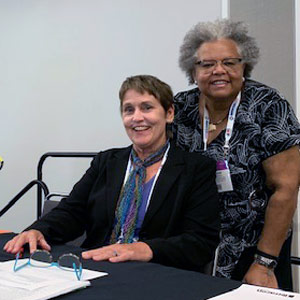In January and February 2021, NIEHS Worker Training Program (WTP) winter webinars focused on COVID-19 prevention, taking on the role of the vaccine and occupational exposure in nonhospital health care settings, respectively. The webinars are offered in both English and Spanish.
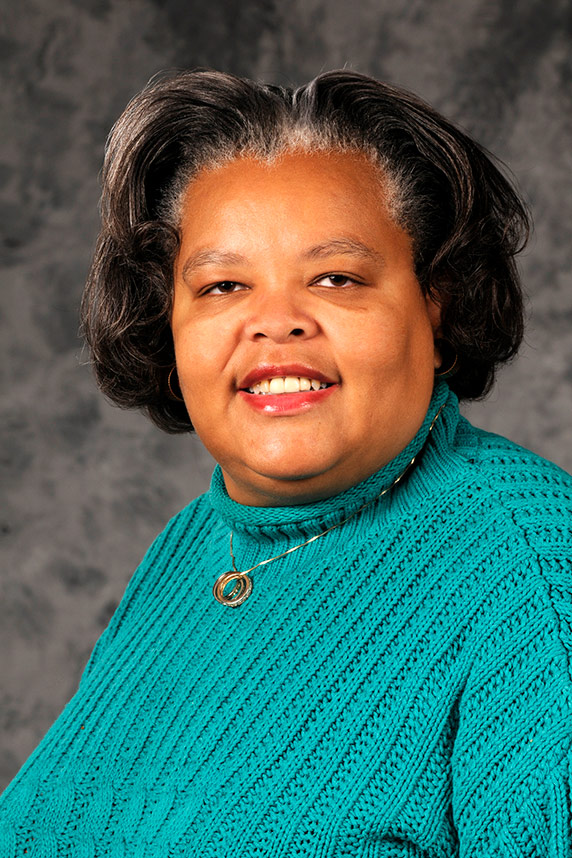 Beard oversees a multimillion dollar portfolio of worker training grants for hazardous waste handling and transport, emergency response, and nuclear and radiation safety. (Photo courtesy of Steve McCaw / NIEHS)
Beard oversees a multimillion dollar portfolio of worker training grants for hazardous waste handling and transport, emergency response, and nuclear and radiation safety. (Photo courtesy of Steve McCaw / NIEHS)The webinars feature “great voices for you to hear from on the frontline, from those in hospital settings and other facilities, such as long-term care facilities, and then also from the people who work in dealing with health and safety in different voices,” said Sharon Beard. The acting WTP director has more than 25 years in leadership of the Environmental Career Worker Training Program.
January — vaccine and trust
The Jan. 14 webinar(https://tools.niehs.nih.gov/wetp/?id=2592), on the role of the COVID-19 vaccine in the workplace, explored mistrust, weeding through misinformation, and improving worker protection. Experts from the broader occupational safety and health community shared their experiences with the COVID-19 vaccine and answered questions from attendees.
Panelists described the science behind the vaccine and why it is so critical to stopping the pandemic, particularly in disadvantaged communities where mortality rates are higher. Discussions highlighted innovative efforts to help train and educate workers, their families, and the community on safety and health.
At the start and end of the event, participants were polled on whether they would get the vaccine, if offered. Organizers noted a 6% increase in answers of “strongly agree” during the second poll.
Amber Mitchell, Dr.P.H., senior science advisor to WTP, helped introduce the audience to the speakers. “It is only together that we can listen, question, and learn and continue to advocate and fight for the safest work environments possible for the American workforce,” she said. “That will include broad adoption of vaccines without losing sight, of course, on constant focus of preventive controls we know work.”
 Mitchell supports WTP in their COVID-19 response, providing technical expertise on occupational exposures to infectious diseases. (Photo courtesy of Amber Mitchell)
Mitchell supports WTP in their COVID-19 response, providing technical expertise on occupational exposures to infectious diseases. (Photo courtesy of Amber Mitchell)February — Nonhospital health care workers
Anyone following pandemic news hears a great deal on protecting health care personnel in hospital settings. However, as the Feb. 17 webinar pointed out, there are unique risks to workers in clinics, nursing homes, long-term care, emergency response, and home health.
Panelists in this webinar spoke about a variety of challenges:
- Emergency response personnel facing rapidly developing situations.
- Best practices for adequate building ventilation.
- Physical distancing and barriers.
- Respiratory protection.
- Protections for home care workers.
- Difficulties with inadequate staffing ratios.
Panelist Lori Stoney, Homewood, Alabama Fire Department battalion chief and Emergency Medical Services director, shared a success story. Her county prepared for COVID-19 by acting early, changing protocols in mid-March last year, ahead of Alabama’s first confirmed case of the virus.
“We were never short masked, short gowned, (or) short gloved, because we got all that pushed in at the beginning,” she said.
Stoney said that the lessons learned from her experiences during the ongoing response have increased Jefferson County’s capacity for future disaster response.
The February worker safety webinar is part of a larger NIEHS WTP COVID-19 Winter Webinar Series and Environmental Justice and Natural Disasters Town Hall Meetings(https://tools.niehs.nih.gov/wetp/?id=2460). This broad and coordinated effort continues educating and training occupational safety and health professionals and the public on responding to the pandemic.
(Kelley Christensen is a contract writer and editor for the NIEHS Office of Communications and Public Liaison.)






